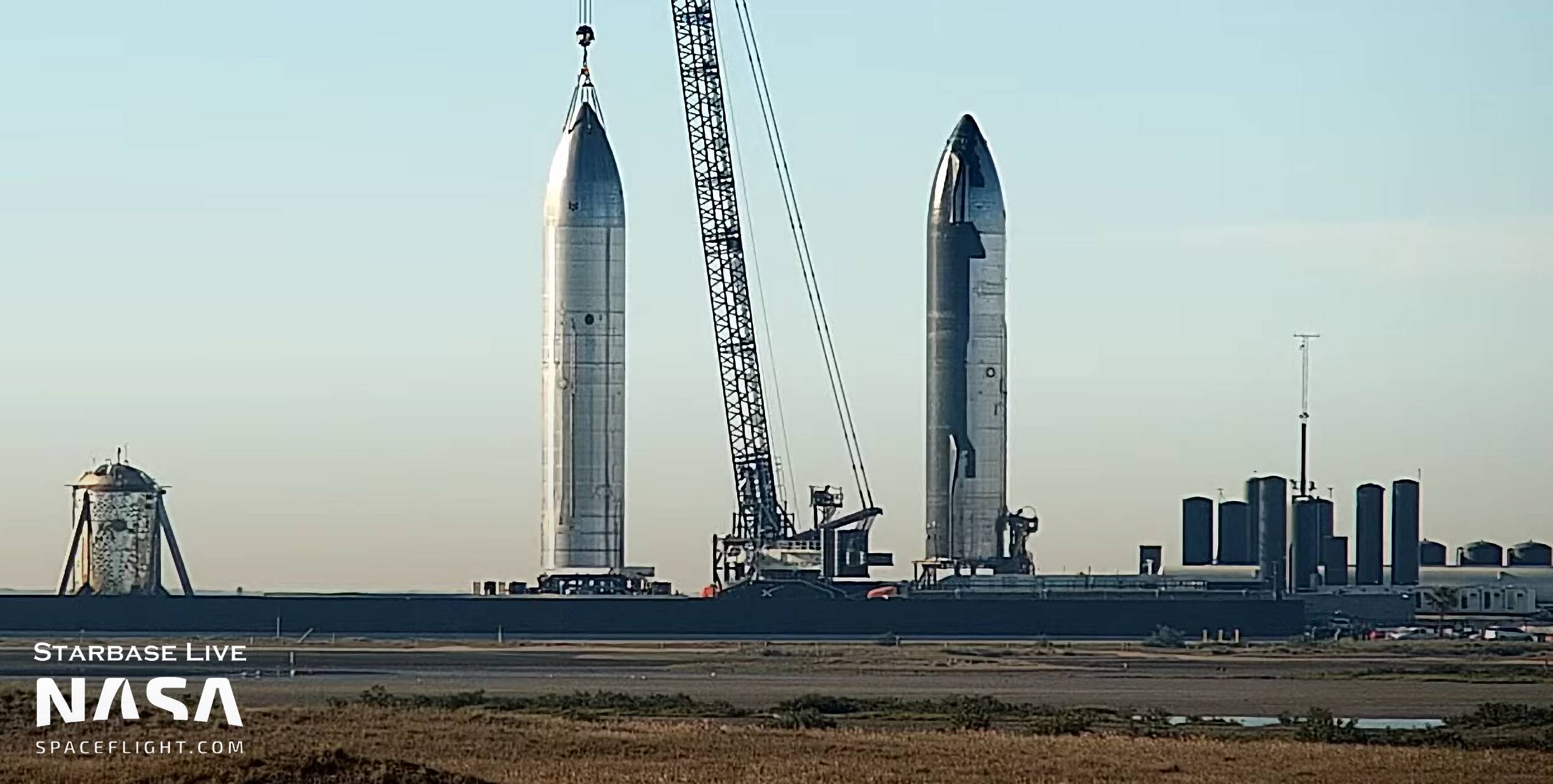

News
SpaceX rolls naked Starship prototype to test site
SpaceX has rolled a strange, naked Starship prototype from its Starbase, Texas factory to a nearby test site.
Beginning with its cone-tipped nose section, SpaceX started stacking Starship S26 in October 2022. By early January 2023, the prototype had been stacked to its full 50-meter (~165 ft) height and welded together. After about six more weeks of outfitting, Ship 26 left Starbase’s High Bay assembly facility and was transported to one of two stands formerly used for suborbital Starship test flights.
SpaceX lifted Ship 26 onto Suborbital Pad A on the morning of February 12th. Just a few hundred feet to the left, Starship prototype S25 watched from Suborbital Pad B while waiting for the start of its Raptor engine test campaign. Ship 26 is four months younger than Ship 25 and rolled out without Raptors installed, as it still needs to pass several simpler tests. That’s far from the only difference between the Starships.
The update that's rolling out to the fleet makes full use of the front and rear steering travel to minimize turning circle. In this case a reduction of 1.6 feet just over the air— Wes (@wmorrill3) April 16, 2024
Starbullet
Aside from a range of smaller design changes, Ship 26 has three main differences relative to most prior Starships. First, it has zero heat shield tiles. Since the 2020-2021 period of suborbital Starship flight testing, all finished ships (S20, S21, S22, S24, S25) have been fitted with ~10,000 black, ceramic heat shield tiles. Eventually, those tiles will (theoretically) protect Starships from the intense heat created by reentering Earth’s atmosphere at orbital velocity.
Ship 26 also has no flaps. Since SpaceX first fully assembled a Starship in October 2020, every ship the company has completed (SN8, SN9, SN10, SN11, SN15, SN16, S20, S21, S22, S24, S25) has had four large flaps and form-fitting ‘aerocovers’ installed. Starships need flaps to steer and orient themselves during orbital reentries. They also need flaps to control themselves during exotic landing maneuvers, which require ships to free-fall belly-down (like a human skydiver) and aggressively flip into a vertical orientation for propulsive landings.
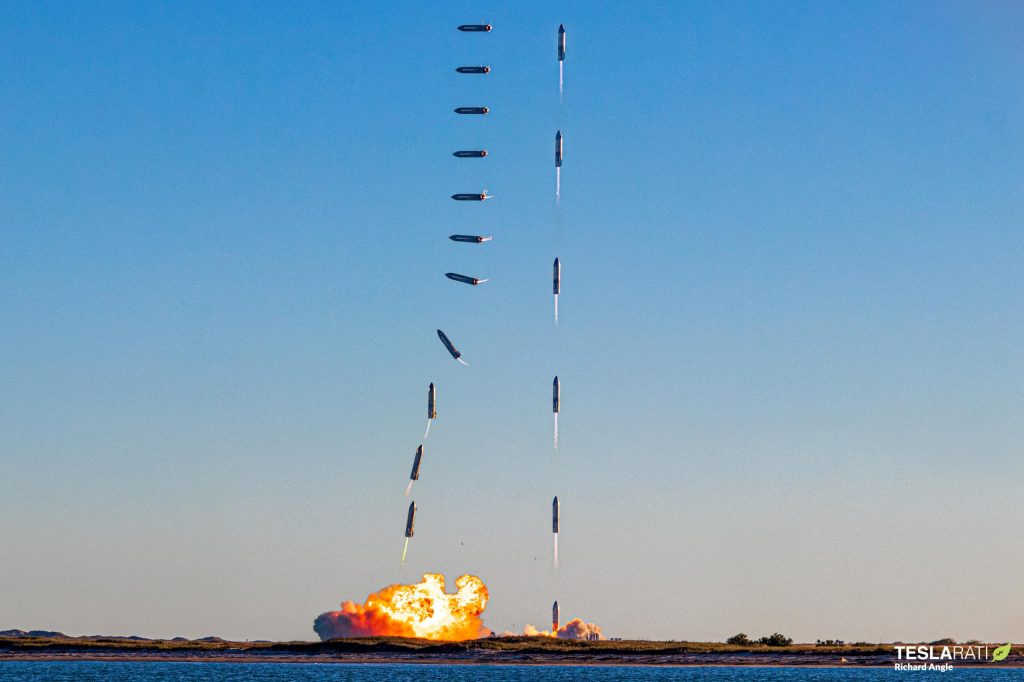
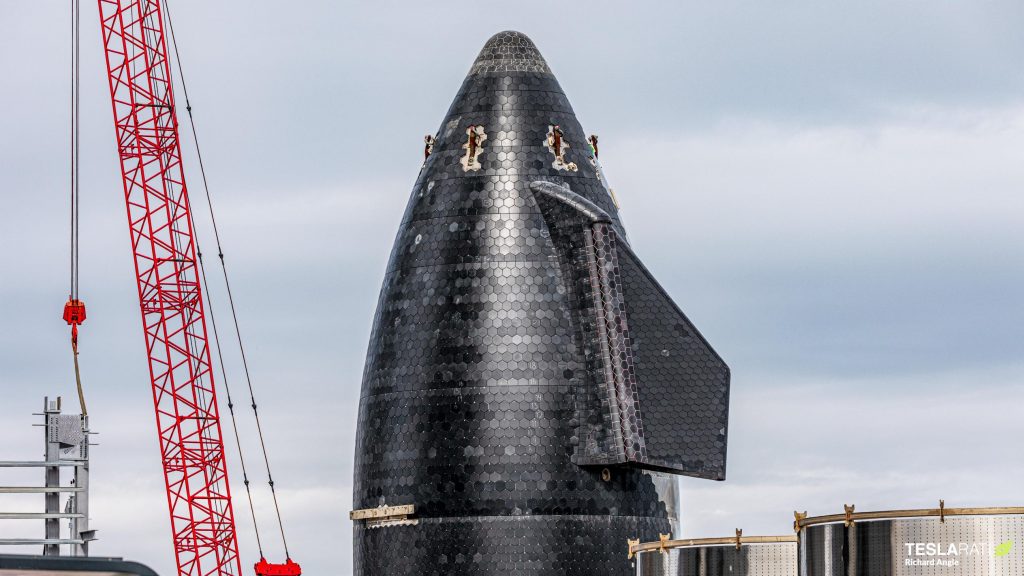
Finally, and most confusingly, Ship 26 has no payload bay of any kind. The end result is a smooth, featureless Starship that looks like a steel bullet, can’t return to Earth, and can’t deploy satellites. Combined, the fact it exists at all almost seems like an elaborate, multi-month mistake. But SpaceX clearly intended to build Ship 26 and is now preparing to qualify it for flight.
Depot, Moon lander, or something else?
In simpler terms, Ship 26 is an intentionally expendable Starship with no way to launch satellites. That raises the obvious question: why does it exist? There are a few obvious possibilities. SpaceX is developing at least four types of Starships. The Crew and Tanker Ships will have heat shields and flaps. The Starship Moon lander will have no flaps or heat shield and will be painted white and insulated. A Depot Ship with stretched tanks will stay in orbit permanently and store propellant for in-space refilling.
Based on low-resolution renders, the bullet-like Depot Ship is the most reminiscent of Ship 26. However, there’s no evidence that Ship 26 has “exterior optical properties [optimized] for long duration [propellant storage].” The prototype also lacks any of the hardware likely needed for docking or propellant transfer and has propellant tanks that are the same size as past ships. To survive in orbit for days or weeks, it would need some kind of power source – typically solar arrays – that isn’t present. And even if an expendable Starship like S26 can already achieve SpaceX’s reported target of 250 tons (~550,000 lb) to low Earth orbit, 250 tons is only a fifth of a full propellant load.
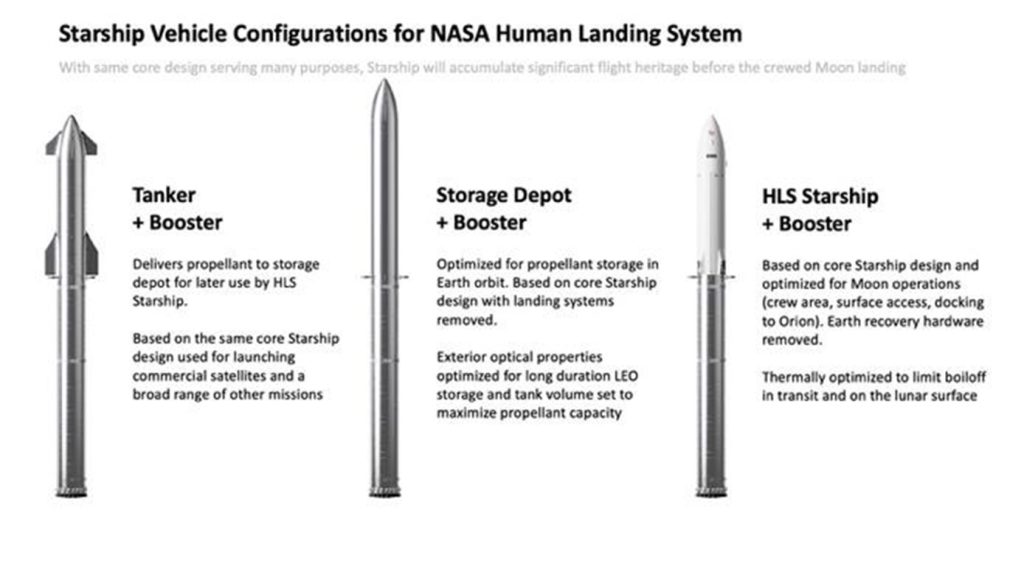
Ship 26 could also be used for miscellaneous systems testing or a longevity demonstration in orbit. However, it’s unclear why SpaceX couldn’t simply do that with Ship 24 and Ship 25. Both have had their payload bays permanently sealed, meaning that they are only useful as test articles. The same is true for a tank-to-tank propellant transfer test SpaceX received a NASA contract to conduct in 2020. During that test, Starship will transfer “10 metric tons” of cryogenic liquid oxygen (LOx) between its main LOx tank and a smaller header LOx tank used to store landing propellant. But all Starships built to date have header tanks and could be used for the same test.
Ship 26 could exist primarily to demonstrate that a Starship with no flaps or heat shield tiles is aerodynamically stable during launch. However, expending an entire Starship for what amounts to wind tunnel testing would be extravagant.
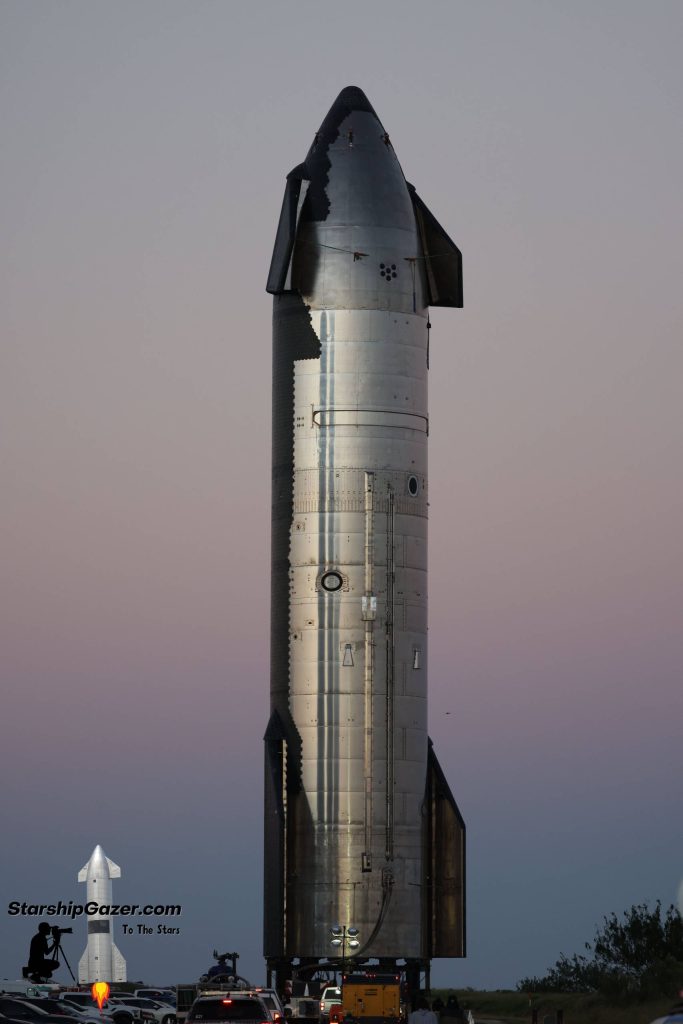
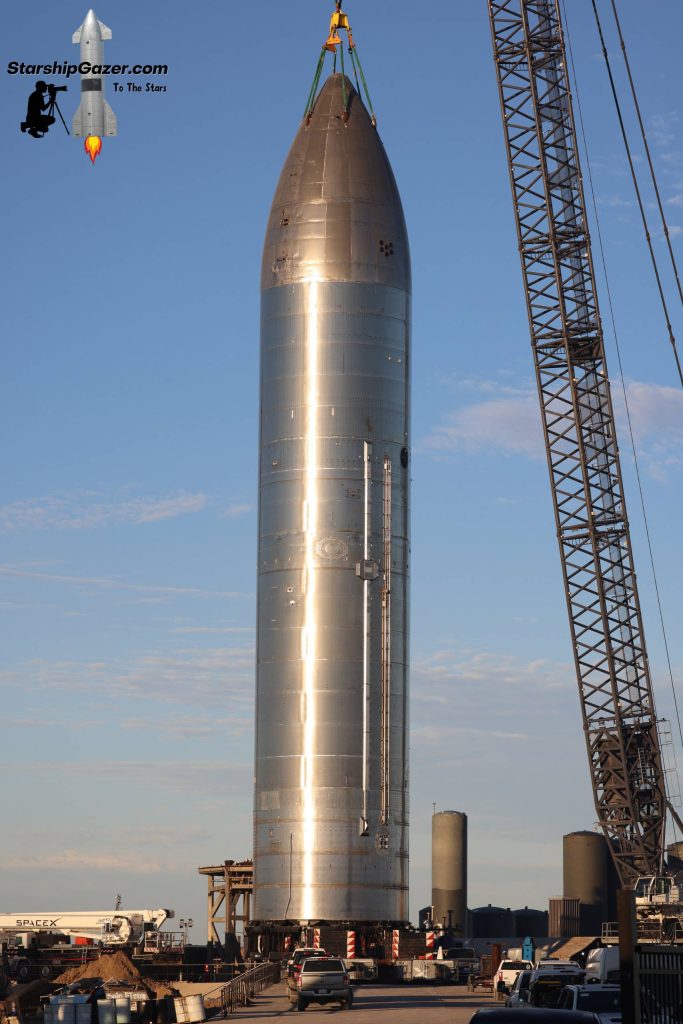
Preparing for flight
Regardless, Ship 26 is clearly destined for more than the scrapyard. The bullet-like prototype was installed on Suborbital Pad A, which SpaceX has modified for cryogenic proofing and structural testing. While coordinating with Ship 25, which needs to conduct static fire tests, Ship 26 will be pressurized and loaded with liquid nitrogen, liquid oxygen, or both to safely simulate the thermal and mechanical loads it will experience when filled with propellant. The stand is fitted with hydraulic rams that can simultaneously simulate the thrust of six Raptor engines (1380 tons / 3M lbf).
If it passes those tests, SpaceX will presumably return Ship 26 to the Starbase factory for Raptor installation. Strangely, the smooth Starship isn’t alone. It appears that Ship 27 will be more or less identical, with no heat shield or flaps. However, there’s evidence that Ship 27 will have the first working payload bay on a Starship and could be used to deploy full-size Starlink V2 satellites in addition to any other testing SpaceX wants to use it for.
The most exotic (and unlikeliest) explanation for Ship 26 and Ship 27 is that the pair is meant to support SpaceX’s first Starship docking and propellant transfer test. In October 2022, a NASA official indicated that SpaceX’s second Starship test flight would be a “Starship-to-Starship propellant transfer.”
For now, SpaceX’s priority is preparing Ship 24 and Super Heavy Booster 7 for Starship’s first orbital launch attempt, followed by preparing Ship 25 and Booster 9 for the second orbital test flight. Until then, Ship 26 and Ship 27 will likely remain a bit of a mystery.
News
Tesla begins Robotaxi certification push in Arizona: report
Tesla seems serious about expanding its Robotaxi service to several states in the coming months.

Tesla has initiated discussions with Arizona transportation regulators to certify its driverless Robotaxi service in the state, as per a recent report from Bloomberg News. The move follows Tesla’s launch of its Robotaxi pilot program in Austin, Texas, as well as CEO Elon Musk’s recent comments about the service’s expansion in the Bay Area.
The Arizona Department of Transportation confirmed to Bloomberg that Tesla has reached out to begin the certification process for autonomous ride-sharing operations in the state. While details remain limited, the outreach suggests that Tesla is serious about expanding its driverless Robotaxi service to several territories in the coming months.
The Arizona development comes as Tesla prepares to expand its service area in Austin this weekend, as per CEO Elon Musk in a post on X. Musk also stated that Tesla is targeting the San Francisco Bay Area as its next major market, with a potential launch “in a month or two,” pending regulatory approvals.
Tesla first launched its autonomous ride-hailing program on June 22 in Austin with a small fleet of Model Y vehicles, accompanied by a Tesla employee in the passenger seat to monitor safety. While still classified as a test, Musk has said the program will expand to about 1,000 vehicles in the coming months. Tesla will later upgrade its Robotaxi fleet with the Cyercab, a two-seater that is designed without a steering wheel.
Sightings of Cybercab castings around the Giga Texas complex suggests that Tesla may be ramping the initial trial production of the self-driving two-seater. Tesla, for its part, has noted in the past that volume production of the Cybercab is expected to start sometime next year.
In California, Tesla has already applied for a transportation charter-party carrier permit from the state’s Public Utilities Commission. The company is reportedly taking a phased approach to operating in California, with the Robotaxi service starting with pre-arranged rides for employees in vehicles with safety drivers.
News
Tesla sets November 6 date for 2025 Annual Shareholder Meeting
The automaker announced the date on Thursday in a Form 8-K.

Tesla has scheduled its 2025 annual shareholder meeting for November 6, addressing investor concerns that the company was nearing a legal deadline to hold the event.
The automaker announced the date on Thursday in a Form 8-K submitted to the United States Securities and Exchange Commission (SEC). The company also listed a new proposal submission deadline of July 31 for items to be included in the proxy statement.
Tesla’s announcement followed calls from a group of 27 shareholders, including the leaders of large public pension funds, which urged Tesla’s board to formally set the meeting date, as noted in a report from The Wall Street Journal.
The group noted that under Texas law, where Tesla is now incorporated, companies must hold annual meetings within 13 months of the last one if requested by shareholders. Tesla’s previous annual shareholder meeting was held on June 13, 2024, which placed the July 13 deadline in focus.
Tesla originally stated in its 2024 annual report that it would file its proxy statement by the end of April. However, an amended filing on April 30 indicated that the Board of Directors had not yet finalized a meeting date, at least at the time.
The April filing also confirmed that Tesla’s board had formed a special committee to evaluate certain matters related to CEO Elon Musk’s compensation plan. Musk’s CEO performance award remains at the center of a lengthy legal dispute in Delaware, Tesla’s former state of incorporation.
Due to the aftermath of Musk’s legal dispute about his compensation plan in Delaware, he has not been paid for his work at Tesla for several years. Musk, for his part, has noted that he is more concerned about his voting stake in Tesla than his actual salary.
At last year’s annual meeting, TSLA shareholders voted to reapprove Elon Musk’s compensation plan and ratified Tesla’s decision to relocate its legal domicile from Delaware to Texas.
Elon Musk
Grok coming to Tesla vehicles next week “at the latest:” Elon Musk
Grok’s rollout to Tesla vehicles is expected to begin next week at the latest.

Elon Musk announced on Thursday that Grok, the large language model developed by his startup xAI, will soon be available in Tesla vehicles. Grok’s rollout to Tesla vehicles is expected to begin next week at the latest, further deepening the ties between the two Elon Musk-led companies.
Tesla–xAI synergy
Musk confirmed the news on X shortly after livestreaming the release of Grok 4, xAI’s latest large language model. “Grok is coming to Tesla vehicles very soon. Next week at the latest,” Musk wrote in a post on social media platform X.
During the livestream, Musk and several members of the xAI team highlighted several upgrades to Grok 4’s voice capabilities and performance metrics, positioning the LLM as competitive with top-tier models from OpenAI and Google.
The in-vehicle integration of Grok marks a new chapter in Tesla’s AI development. While Tesla has long relied on in-house systems for autonomous driving and energy optimization, Grok’s integration would introduce conversational AI directly into its vehicles’ user experience. This integration could potentially improve customer interaction inside Tesla vehicles.
xAI and Tesla’s collaborative footprint
Grok’s upcoming rollout to Tesla vehicles adds to a growing business relationship between Tesla and xAI. Earlier this year, Tesla disclosed that it generated $198.3 million in revenue from commercial, consulting, and support agreements with xAI, as noted in a report from Bloomberg News. A large portion of that amount, however, came from the sale of Megapack energy storage systems to the artificial intelligence startup.
In July 2023, Musk polled X users about whether Tesla should invest $5 billion in xAI. While no formal investment has been made so far, 68% of poll participants voted yes, and Musk has since stated that the idea would be discussed with Tesla’s board.
-

 Elon Musk1 week ago
Elon Musk1 week agoTesla investors will be shocked by Jim Cramer’s latest assessment
-

 Elon Musk3 days ago
Elon Musk3 days agoElon Musk confirms Grok 4 launch on July 9 with livestream event
-

 Elon Musk11 hours ago
Elon Musk11 hours agoxAI launches Grok 4 with new $300/month SuperGrok Heavy subscription
-

 News7 days ago
News7 days agoTesla Model 3 ranks as the safest new car in Europe for 2025, per Euro NCAP tests
-

 Elon Musk2 weeks ago
Elon Musk2 weeks agoA Tesla just delivered itself to a customer autonomously, Elon Musk confirms
-

 Elon Musk1 week ago
Elon Musk1 week agoxAI’s Memphis data center receives air permit despite community criticism
-

 Elon Musk2 weeks ago
Elon Musk2 weeks agoTesla’s Omead Afshar, known as Elon Musk’s right-hand man, leaves company: reports
-

 News2 weeks ago
News2 weeks agoXiaomi CEO congratulates Tesla on first FSD delivery: “We have to continue learning!”


















